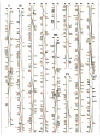Genetic and physical maps of Saccharomyces cerevisiae
- PMID: 9169866
- PMCID: PMC3057085
Genetic and physical maps of Saccharomyces cerevisiae
Abstract
Genetic and physical maps for the 16 chromosomes of Saccharomyces cerevisiae are presented. The genetic map is the result of 40 years of genetic analysis. The physical map was produced from the results of an international systematic sequencing effort. The data for the maps are accessible electronically from the Saccharomyces Genome Database (SGD: http://genome-www.stanford. edu/Saccharomyces/).
Figures






References
-
- Mortimer RK, Hawthorne DC. Methods Cell Biol. 1975;11:221–233. - PubMed
MeSH terms
Grants and funding
LinkOut - more resources
Full Text Sources
Other Literature Sources
Molecular Biology Databases
